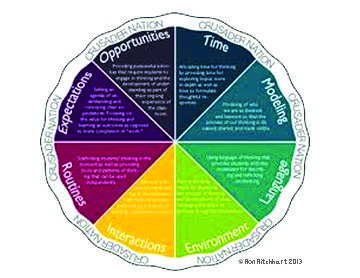
What do you value? The beliefs, messages, and behaviors that you value work together to create classroom culture. If you value dispositions, such as the ability to be reflective, collaborative, or imaginative, then you will provide multiple opportunities for students to develop these dispositions, so that they become ingrained, or enculturated, into your classroom. As Vygotsky noted, “Children grow into the intellectual life of those around them.” How can we surround our students with a rich intellectual life? What are ways that we model deep thinking and show that we value a culture of learning?
By focusing on the Eight Cultural Forces, we can identify concrete ways to transform the culture of math teaching and learning in our schools. You will find that the forces overlap and interact together; they should not be seen as a checklist, and there is no one force that is more important than the others. The first four forces are perhaps a good starting place, as they help build a foundation. Once this foundation is in place, planning lessons and experiences that incorporate the remaining four forces will become easier.
Expectations. This does not refer to our expectations of students but our expectations for students. To transform the culture of math, we must communicate our expectations for students: they will focus on deep learning, rather than just completing work; they will be able to learn both independently and collaboratively; and they will learn from their mistakes and persist through challenges.
Language. Our words have the power to define the culture of the classroom. What language would a mathematician use? Do your students have the opportunity to speak the language of math? As students work through problems, note and name the strategies and dispositions used. When we intentionally and explicitly communicate the types of thinking being used, students develop their metacognition and demonstrate these behaviors more frequently.
Time. Are your math values and beliefs reflected in the way your math class is structured? Would students be able to identify what is valued? When leading a whole-class number talk, give students wait time to think before they share. Take the time to fully explore one rich problem rather than zooming through a dozen surface-level problems. Students should leave the math class feeling energized and excited, not stressed and overloaded.
Modeling. As teachers, we are very familiar with instructional modeling; however, this doesn’t shape the culture of the classroom. We must model our own thinking dispositions, calling attention to times that we are reflective, creative, or taking risks. Be authentic; when you share your own struggles and passions as a thinker and learner, students will feel safe to do the same.
Opportunities. Rather than planning lessons and assignments that ask students to demonstrate only content knowledge, plan opportunities that allow them to challenge misconceptions, build evidence to support a claim, or consider multiple strategies. Powerful learning opportunities are low-floor, high-ceiling problems in which students need to apply content and skills in new ways, to solve authentic problems.
Routines. In a well-managed classroom, established routines are everywhere, from how to clean up manipulatives to how to work together in a small group. Consider the power of adding visible thinking and learning routines: Intentionally and consistently plan when and how to use these routines, and they will become a pattern of behavior.
Interactions. This is the force that has the most impact on the culture of a math classroom. Positive interactions and relationships show “a respect for and value of one another’s contributions of ideas and thinking in a spirit of ongoing collaborative inquiry” (Ritchhart 2002). The most powerful learning opportunities arise when students learn from one another. To achieve this, we must create an autonomous learning environment in which students feel that their thinking is valued.
Environment. The physical environment of the classroom can enhance learning and build culture. Student thinking and learning should be visible throughout the classroom. Learning is dynamic; create a space that is flexible and responsive to the changing needs of your learners.
If you want to truly transform the way math is taught and learned, focus on the culture first.
This is the third and final post in a 3-part series, published on NCTM’s Teaching Children Mathematics blog.
In part 1 of this blog series, we focused on the need to build a school culture in which mathematical thinking is valued, visible, and actively promoted. In part 2, we looked at Making Thinking Visible routines that can support rich mathematical understanding and discussion. In this final post, we will examine how to develop students as powerful mathematical thinkers and learners, by leveraging Ron Ritchhart’s Eight Cultural Forces.
Share this:




